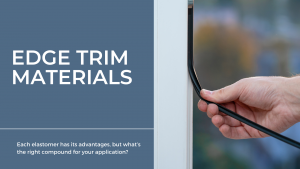Learn how to select the right anti-vibration mount by asking and answering a few questions. If you’re a manufacturer, you can also contact Elasto Proxy to discuss your vibration control application.
Which type of anti-vibration mount are you looking for?
There are three main types, or categories.
- Standard
- Bell
- Machinery
But what makes it a “standard” mount? And aren’t all anti-vibration mounts used with machinery? To eliminate confusion, check out the descriptions below and look at the pictures on this page. Do any of these products seem like what you need?
Standard anti-vibration mounts are installed within or under equipment. When they’re installed within a machine, it’s typically between two parts like a motor and a metal frame. Typically, standard mounts are cylindrical (bobbin-style) and have male or female ends. Here, the term “male” indicates that there’s a threaded fastener and the term “female” indicates that there’s a threaded insert. Keep in mind, however, that this product category also includes rubber feet and position limiters.
Bell anti-vibration mounts attach to machinery. This might seem confusing since there’s also a product category called “machinery mounts”, but what makes bell mounts different is their distinctive school bell shape. Bell mounts don’t have fasteners, so you don’t have to worry about “male” and “female” ends. What these products have, however, are bolt holes. Here’s something else to keep in mind. Bell mounts have a flat surface to prevent the horizontal movement of machinery. Is that something that you need?
Machinery mounts don’t include bell mounts, but this category includes all of the other anti-vibration mounts that are used under (rather than within) machines. Some machinery mounts are cylindrical, but others are rectangular. So, don’t just consider the shape. It’s easier if you’re looking for a replacement part, of course, but what if you’re not? Keep reading for answers.
Which type of rubber does the anti-vibration mount need?
The anti-vibration mounts that Elasto Proxy supplies are rubber-to-metal bonded assemblies. But why is rubber used in the first place? It’s because elastomers are some of the best materials for absorbing energy from vibrations. Yet, all rubber isn’t the same. For example, if your application requires abrasion resistance, then natural rubber (NR) might be the right choice.
Still, NR is hardly your only option. Sometimes, SBR is used because it combines abrasion resistance with better aging properties. If oil resistance is required, then neoprene is a good choice. There are also anti-vibration mounts that use EPDM for weather resistance. Silicone anti-vibration mounts aren’t as common, but they’re available for applications that require broad temperature resistance.
What thread size do you need – and what about other fastener dimensions?
This isn’t a question that applies to every anti-vibration mount, but it’s an important one for products that use a threaded fastener. If you’re familiar with Machinery’s Handbook, you already know that there are many different inch-based and millimeter-based threads. Fasteners differ in length, too. You don’t want one that’s too short, but you also don’t want one that’s so long it won’t fit within the application.
Here’s a related concern. Do you need to install an anti-vibration mount between, say, a motor and a metal frame? Then you’ll need to know how much room there is between these two components. Otherwise, the anti-vibration mount might not fit – or might not fit well enough. Rubber can support some compression, but you don’t want rubber that’s so hard it won’t compress or so soft it won’t bounce back.
Do you need a vibration isolator or a vibration dampener?
What’s the difference between isolation and dampening? Vibration isolators prevent the transmission of vibrations. Vibration dampeners, or vibration dampers, reduce the amount of vibrational energy that is transmitted instead. So, do you need to prevent vibrations from traveling from, say, an engine bay to a cab? Or do you need to reduce vibrations once they’re inside the cab itself? It could be both.
Where is the equipment located and how is it supported?
Let’s say you need to control the vibrations from a piece of machinery. Is it floor-mounted, ceiling-mounted, or sitting on a tabletop somewhere? Sometimes, these surfaces aren’t as level as you’d like. If that’s the case, you may need an anti-vibration mount that’s self-leveling to accommodate the pitch in the floor. The way that machinery is supported matters, too. Something that’s ceiling mounted (such as an HVAC unit) might be susceptible to more vibrations.
How much does the equipment weigh when it’s empty and full?
What is the weight of the equipment? And do you add heavy items to it? Realistically, a vibration mount that’s rated for a small piece of equipment probably isn’t a good choice for a machine that weighs two tons. By the same token, two machines that weigh the same might need to move or convey materials that weigh different amounts. Does the added weight make a big difference? A lot of it depends on loads.
What is the static load? What is the dynamic load?
These are two of the most important questions you’ll need to ask and answer. If you’re an engineer, you’re probably familiar with these terms already. If you’re not, then some basic definitions and an example might help. First, let’s look at some definitions. A static load is when the equipment is in a fixed position. A dynamic load involves force that is applied rapidly.
Think of an elevator in a high-rise building. It’s on the very top floor. The doors to the elevator open and a group of people walk in and stand still. That’s a static load. Then the elevator starts to move and the people shift from foot to foot. That’s a dynamic load. To control the vibrations in this application, you can’t just look at one load. You need to consider both.
How many anti-vibration mounts do you need? And what are the dimensions for each one?
This is an easy one to answer if you’re replacing existing mounts or can clearly observe where to attach them. Let’s say that your equipment is square-shaped and weighs 400 lbs. There’s also a place to attach an anti-vibration mount on each side of the square. Assuming that the center of gravity is right in the middle, then you’d need four mounts, each that can handle 100 lbs. (but don’t forget about the static and dynamic loads).
What is the larger application environment like?
This last question is also the easiest to answer if you’ve considered which rubber you need to use. Will the anti-vibration mount come into contact with industrial chemicals, petroleum oils, or cleaners? What about mud, water, and tropic or arctic temperatures? There’s a lot to consider during anti-vibration mount selection, but manufacturers who partner with Elasto Proxy can find what they need.r










